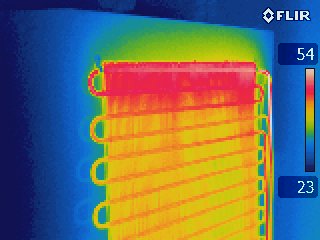Why should we care?
Now that we have explored the energy transfers that accompany phase changes, we can better understand how the internal energy changes of a refrigerant cause heat to be transferred from the inside of a refrigerator to the outside air. Open the Refrigeration Learning Tool. to view the flow of a refrigerant through the various components of a refrigeration cycle. To explore what happens in each component of the refrigerator, click on the numbers that appear beside each component. Pay particular attention to the phase changes that occur in the condenser and evaporator.

Worked Example
How does the refrigerant absorb heat from the inside of a refrigerator and release heat to the air surrounding the refrigerator? Refer to the Refrigeration Learning Tool. as needed.
When the refrigerant enters the evaporator, it vaporizes. Vaporization is an endothermic process, so, by vaporizing, the refrigerant absorbs a large amount of energy from the inside of the refrigerator. After compression, however, the refrigerant condenses within the condenser. Because condensation is an exothermic process, the refrigerant releases a large amount of energy to the air outside of the refrigerator.
The phase changes of water also play an important role in Earth’s climate. The amount of precipitation in a particular region, for instance, depends on the rates of evaporation and condensation of water in that area. However, as the climate changes, there will be important consequences that involve the phase changes of water on Earth.
As global temperatures rise due to the emission of greenhouse gases by human activity, one important consequence relates to the rate of evaporation of water. Although a substance boils at a specific temperature (the boiling point), individual molecules of a substance can escape the liquid phase and enter the gas phase, if they acquire enough energy to break free from the intermolecular forces that hold the substance together as a liquid. This process is called evaporation. If the temperature of a substance increases, the average kinetic energy of the substance’s particles increases, so that a greater number of particles have the energy required to enter the gas phase.